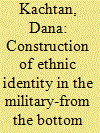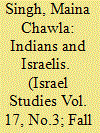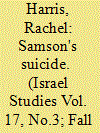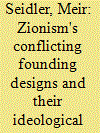|
|
|
Sort Order |
|
|
|
Items / Page
|
|
|
|
|
|
|
| Srl | Item |
| 1 |
ID:
118533


|
|
|
|
|
| Publication |
2012.
|
| Summary/Abstract |
This article reviews the Sino-Israel relationship from the Chinese perspective. It argues that the relationship is at a crossroad because China is increasingly more proactively involved in the international arena, which will inevitably lead to China's more assertive role in trying to facilitate solving the Israel-Palestinian conflicts. China has been inclined to be more supportive to the Palestinian side based on Chinese cultural values, traditionally stronger ties with Arab countries, and also since Palestine is generally considered as the weaker side of the conflict. A strong Israel-U.S. relationship will help balance Israel's relationship with China. The Sino-Israel relationship cannot be viewed out of the context of a Sino-U.S. relationship. China is more concerned with its relationship with the U.S., the only other world economy comparable in size to China's, in order to protect the peaceful world order for further development. Future Chinese involvement with the Palestinian region will be more constructive.
|
|
|
|
|
|
|
|
|
|
|
|
|
|
|
|
| 2 |
ID:
118539


|
|
|
|
|
| Publication |
2012.
|
| Summary/Abstract |
This article examines how ethnicity is created, maintained, and perpetuated in the Israel Defense Forces (IDF). Research studies on ethnicity in the Israeli army have examined ethnicity while focusing on the macro, emphasizing the way the structure and the policy of the army, alongside its reciprocal relations with the greater society and the state, maintain and reproduce ethnicity. It focuses on the micro point of view, hitherto neglected, which emphasizes the soldiers' experience and interpretation. Using a case study of two Israeli infantry brigades, the article demonstrates how ethnicity is produced, maintained, and reproduced by individuals through practices, behavior, perceptions, and observations.
|
|
|
|
|
|
|
|
|
|
|
|
|
|
|
|
| 3 |
ID:
118537


|
|
|
|
|
| Publication |
2012.
|
| Summary/Abstract |
Widespread agreement exists that Israeli masculinity constitutes a total negation of previous forms of Jewish masculinity. This view fails to fully explain pre-state and contemporary Israeli developments. With Jewish masculinity tied to evolving Palestinian Zionism, it proves more effective to recognize Israeli masculinity's contested nature from its inception. Analyzing the first full-length drama of Palestinian Jewish settlement, Levi Aryeh Arieli's 1911 Allah Karim, this article will illustrate this contestation, as well as bring an important and largely obscured Israeli masculine model to light. He and other prominent early twentieth century Hebrew writers proved less interested in masculinities grounded in transformed bodies or altered relationships to land or non-Jews. Instead they positively engaged Diasporic Jewish masculinity to develop a Zionist masculinity that they deemed best able to meet the emergent Yishuv's needs. Introspection and effective decision making for accomplishment of individual and collective aims constituted the basis for this masculine form.
|
|
|
|
|
|
|
|
|
|
|
|
|
|
|
|
| 4 |
ID:
118534


|
|
|
|
|
| Publication |
2012.
|
| Summary/Abstract |
India and Israel established full diplomatic relations in 1992. Bilateral trade has grown from $200m in 1992 to $5b in 2010. High-level collaboration in defense, science, and IT reflect inter-governmental trust and a stable partnership. Israelis and Indians interact along many axes as they traverse each other's terrains. However, these exchanges find only peripheral reference in official discourses and have received little scholarly investigation. Over 40,000 Israelis visit India annually and 70,000 Indian Jews live in Israel, aside from other (non-Jewish) Indian community clusters. What is the nature of Indian-Israeli encounters socially, culturally, and politically? Do they impact the meta-narrative of India-Israel relations? How can people-to-people synergies be better harnessed to bolster the bilateral relationship?
|
|
|
|
|
|
|
|
|
|
|
|
|
|
|
|
| 5 |
ID:
118538


|
|
|
|
|
| Publication |
2012.
|
| Summary/Abstract |
Israeli art music reveals that the soundtrack of Israeli history is greater than the sum of its parts, which usually include popular and folk music genres. Surveying the development of Israeli art music from the late 1930s to the 1970s, this article attempts to transcend the periodic partitions that characterize the field's historiography, which has had little contact with recent historical and historiographic shifts in the study of Israeli history. Focusing on four synchronous vectors-namely, processes of autoexoticism, asymmetrical musical borrowing, the post-statehood dilution of national sentiment, and the post-67 reemergence of Jewish musical idioms-the article guides the reader through the dissolution of national art music and its post-statehood stratifications.
|
|
|
|
|
|
|
|
|
|
|
|
|
|
|
|
| 6 |
ID:
118536


|
|
|
|
|
| Publication |
2012.
|
| Summary/Abstract |
Drawn from the biblical narrative, the image of Samson came to be used as a depiction of the self-sacrificing nationalistic ideal that dominated Zionist ideology. Though much has been said about the popular and widespread use of this image in Israeli society and culture, I contend that it was not solely his heroism, strength, and symbolic identity as the new Jew that marked this biblical figure for reuse in popular forums, but that his final suicide (martyred sacrifice) underpinned the drama of the Samson narrative. The symbolism of Samson soldiers willing to sacrifice themselves for the modern nation state altered as attitudes towards sacrifice for the collective changed. The heroism of the Samson myth collapsed, and subsequently was inverted, becoming a powerful tool for criticizing the Israeli military hegemony. This article traces a literary history of the changing narrative of the archetypal Samson.
|
|
|
|
|
|
|
|
|
|
|
|
|
|
|
|
| 7 |
ID:
118535


|
|
|
|
|
| Publication |
2012.
|
| Summary/Abstract |
The 1990s witnessed a growing rapprochement in relations between Turkey and Israel, which in a decade's time have become strained, reaching an all-time low with the Mavi Marmara incident in 2010. This article aims to analyze the developments in relations between the two countries mainly in the 2000s. The domestic, regional, and international levels are examined, with special attention to the factors that led to the current state of strained relations between the two countries.
|
|
|
|
|
|
|
|
|
|
|
|
|
|
|
|
| 8 |
ID:
118541


|
|
|
|
|
| Publication |
2012.
|
| Summary/Abstract |
The article deals with two different approaches to the Zionist enterprise that clearly dominated nearly all of the stages of its development: viewing any envisioned return of the Jews to the Land of Israel through a traditional redemptionist prism and a novel perception seeking refuge for a persecuted people. Though the historical schism and the ideological gap between both perceptions are obvious, I try to demonstrate that in terms of real-life ideologies they at times worked hand in hand. The refuge position was neither the exclusive domain of secular Zionists, nor was its redemptionist counterpart limited to the proponents of religious Zionism. Sometimes both positions are echoed by one and the same person. Furthermore, an intermediate position is presented and the reasons for its meager success are scrutinized. The main protagonists here are Herzl, Rabbi Kook, Rabbi Reines, and Ahad Ha'am.
|
|
|
|
|
|
|
|
|
|
|
|
|
|
|
|
|
|
|
|
|